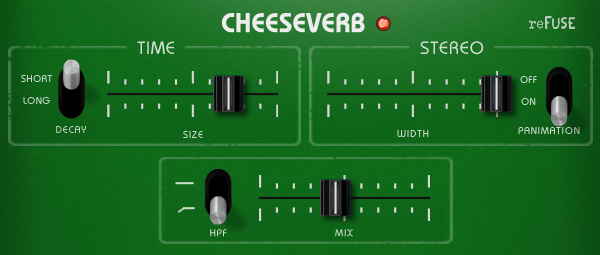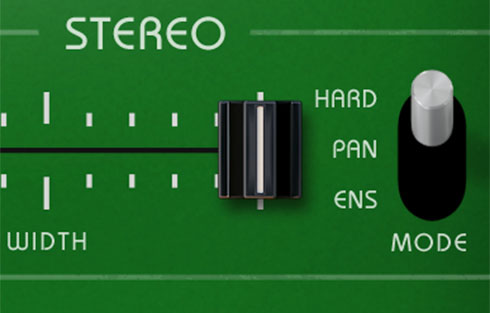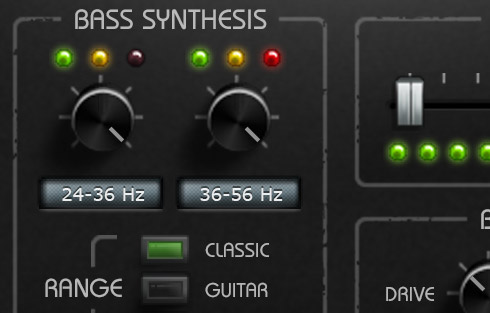Introduction
The Cheeseverb is an analog reverb based on a long out-of-production bucket-brigade delay (BBD) chip with multiple, specially-spaced output taps. Because its virtual BBD clock can run relatively slow, giving it longer delay times, it aggressively rolls off higher frequencies to avoid aliasing. The result is dark and rich, and because of the way it pans its various delay taps across the stereo field, it is particularly useful for taking a mono source and giving it some left-right spread.

Controls
For any of the sliders, you may Command-drag (Mac) / Ctrl-drag (Win) to access fine resolution control.
Size
Controls the time between the delay taps, effectively emulating smaller or larger sized spaces. Under the hood, this is changing the frequency of the simulated BBD clock – from 100 kHz at the smallest size, down to 10 kHz at the largest size. The signal is therefore lowpass filtered at around 4 kHz, in order to minimize aliasing even when running the BBD clock at its slowest speed.
Decay
Controls the level of signal recirculated through the delay circuit (aka feedback). Allows for a shorter or longer tail to the reverb sound.
Width
Controls the panning of the delay taps. At minimum, all taps are panned to center, creating a mono reverb effect. At maximum, alternating taps are hard panned left and right, creating the widest stereo spread.
The stereo width of the dry signal is unaffected by the Width control.
Panimation
When engaged, this slowly modulates the pan positions of the various taps in the stereo field. Without the switch engaged, the first reverb reflection always gets hard-panned to the left side, which psychoacoustically pulls the ear to localize the reverb sound as being skewed leftward. (This is particularly audible when the Width and Mix controls are both turned up high). Sometimes this works to the benefit of a mix, but for times when you might want the reverb to be more diffused in the stereo field, engage the Panimation!
HPF
This applies a highpass filter to the recirculated delay signals only. Helpful to avoid low frequency buildup, especially with longer reverb times and the Long Decay setting. The dry signal is unaffected by the HPF control.
Mix
Controls the blend of dry input signal to reverb. The dry signal is passed through the plug-in unaffected. At minimum, the output signal is 100% dry, and at maximum, the output signal is 100% reverb.
Utility Bar
Along the bottom of the plug-in window you will find the Utility Bar. This is where license management tools and other helpful (but non-audio related) functions reside.
License Management
Depending on whether or not Cheeseverb has been authorized, the license management area in the bottom left of the Utility Bar will have different displays.
In Demo Mode
The display will read Demo Unlock, and mousing over it will change it to a Load License File button. In demo mode:
- Cheeseverb’s settings will not be saved when you close a project file.
- The DAW’s preset menu will only save or load the default settings.
- Every 30 seconds, audio will drop out and a burst of noise will be heard.
To authorize Cheeseverb:
- Log in to your reFuse Software user account, and use the "Download License File" button to save the license file to your desktop.
- Use the “Load License File” button to select the "Cheeseverb_license_file.xml" from your desktop.
- A success message will appear, and offer to move the license file from the Desktop to the Trash. The authorization has been saved at this point, and it is safe to trash the downloaded license file.
In Authorized Mode
The bottom left of the Utility Bar will display your registered username. Mousing over it will change it to a Clear Authorization button. If you click this, a confirmation window will appear, asking if you want to clear the authorization for Cheeseverb off the system.
View Docs
This button will open the Cheeseverb User Guide in your default web browser.
Check for Updates
This button will check with our server to see if you have the most recent update of Cheeseverb. (It does not launch a web browser to do this, the check is done right in the plug-in.)
Presets
No presets are included with Cheeseverb v1.0.1.
Specifications
Virtual BBD clock speed: 10kHz - 100kHz
HPF cutoff frequency: 160 Hz, non-resonant
Credits
Cheeseverb is ©2019 reFuse Software, LLC
VST is a registered trademark of Steinberg Media Technologies GmbH



